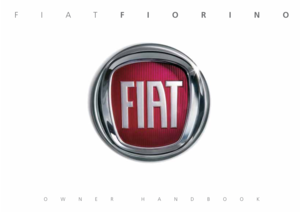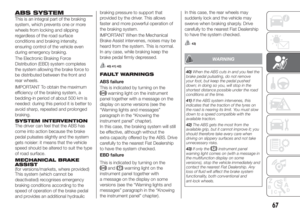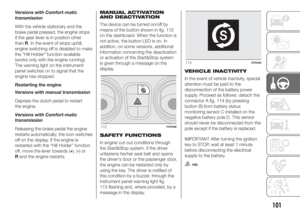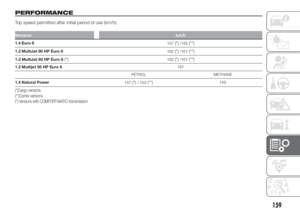Page 81 of 196

SUITABILITY OF PASSENGER SEATS FOR THE USE OF CHILD RESTRAINT
SYSTEMS
The vehicles designed to carry people (homologation M1) comply with the new European Directive 2000/3/EC which governs
the arrangement possibilities for child restraint systems on the seats of the vehicle as shown in the following table:
Group Weight range Front passenger Rear passenger
Airbag enabled Airbag deactivated
Group 0, 0+ up to 13 kgXUU
Group 1 9 - 18 kgXUU
Group 2 15 - 25 kgUUU
Group 3 22–36 kgUUU
X Seat not suitable for children in this weight category.
U suitable for child restraint systems in the "Universal" category, according to European Standard ECE-R44 for the specified "Groups".
WARNING
67)SERIOUS DANGER: When an active passenger airbag is fitted, DO NOT install rear facing child restraint systems on the front seat.
Deployment of the airbag in an accident could cause fatal injuries to the child regardless of the severity of the impact. It is advisable to always
carry children in a child restraint system on the rear seat, which is the most protected position in the event of a collision.
68)Should it be necessary to carry a child on the passenger side front seat in a rearward-facing child restraint system, the passenger side
front airbag and side bag (for versions/markets, where provided) must be deactivated through the Setup menu. Deactivation should be
verified by checking whether the
warning light is switched on in the central dashboard. Move the passenger's seat as far back as possible
to avoid contact between the child seat and the dashboard.
69)On the sun visor there is a label with suitable symbols reminding the user that it is compulsory to deactivate the airbag if a rearward facing
child restraint system is fitted. Always comply with the instructions on the passenger side sun visor (see the "Supplementary Restraint
System (SRS) - Airbag" paragraph).
70)Do not move the front or rear seat if a child is seated on it or on the dedicated child restraint system.
71)Incorrect fitting of the child restraint system may result in an inefficient protection system. In the event of an accident the child restraint
system may become loose and the child may be injured, even fatally. When fitting a restraint system for newborns or children, strictly comply
with the instructions provided by the Manufacturer.
79
Page 82 of 196
72)When the child restraint system is not used, secure it with the seat belt or with the ISOFIX anchorages, or remove it from the vehicle. Do
not leave it unsecured inside the passenger compartment. This way, in the case of sudden braking or an accident, it will not cause injuries
to the occupants.
73)After installing a child restraint system, do not move the seat: always remove the child restraint system before making any adjustment.
74)Always make sure that the diagonal section of the seat belt does not pass under the arms or behind the back of the child. In the event of
an accident the seat belt will not be able to secure the child, with the risk of injury, including fatal injury. Therefore the child must always wear
the seat belt correctly.
75)The figures are only examples for fitting purposes. Fit the child restraint system according to the instructions, which must be included.
80
SAFETY
Page 83 of 196

INSTALLING AN
ISOFIX SEAT
(for versions/markets, where provided)
76) 77)
On some versions the external rear
seats are equipped with ISOFIX
attachments, for fitting child restraint
systems quickly, simply and safely.The ISOFIX system lets you install the
ISOFIX child restraining system without
using the vehicle seat belts but
connecting them directly to the car seat
with three anchors in the vehicle.
Traditional child restraint systems can
be fitted alongside Isofix child restraint
systems on different seats in the same
vehicle.
As an example, fig. 92 shows an
example of a Universal Isofix child
restraint system for weight group: 1.
IMPORTANT The fig. 92 is indicative
and for assembly purposes only. Fit the
child restraint system according to
the instructions, which must be
included.To install an ISOFIX child restraint
system, attach it to the two metal
anchorages A fig. 93 located where the
rear seat cushion meets the backrest,
then fix the upper strap (available
together with the restraint system) to
the dedicated anchorage B fig. 94
located at the bottom behind the
backrest.
Remember that, in the case of
Universal Isofix child seats, you can use
all seats bearing the marking ECE
R44 (R44/03 or later updates)
"Universal Isofix".
The Universal Isofix “Duo Plus” child
seat is available from Lineaccessori
MOPAR.
For any further details on installation/
use, refer to the instruction manual for
the child restraint system.
92F0T001093F0T0145
94F0T0284
81
Page 84 of 196

PASSENGER SEAT COMPLIANCE FOR USING UNIVERSAL ISOFIX CHILD
RESTRAINT SYSTEMS
The table below, according to European Directive ECE 16, shows the different installation possibilities for Isofix restraint
systems on seats fitted with Isofix attachments for versions designed to carry people (homologation M1).
Weight groupChild restraint system
positionIsofix size class Rear side Isofix position
Group 0 (up to 10 kg) Rear facing EIL
Group 0+ (up to 13 kg)Rear facing E
IL
Rear facing DIL (*)
Rear facing CIL (*)
Group I (from 9 to 18 kg)Rear facing D
IL (*)
Rear facing CIL (*)
Forward facing BIUF
Forward facing B1IUF
Forward facing AIUF
IL Suitable for Isofix child restraint systems of the "Specific for the vehicle", "Restricted", or "Semiuniversal" categories, approved for this type of vehicle.
(*) The ISOFIX child restraint system may be fitted by moving the front seat forward.
IUF Suitable for forward facing Isofix child restraint systems, Universal class, approved for the weight group.
NOTE The other weight groups are covered by specific ISOFIX child restraint systems, which can be used only if specifically
tested and approved for this vehicle (see list of vehicles provided with the child restraint system).
82
SAFETY
Page 85 of 196

Below is a summary of
the main safety rules to
be followed when
carrying children
Main recommendations to carry
children safely:
Install the child restraint systems on
the rear seat, which is the most
protected position in the event of an
impact.
Keep children in rearward facing
child restraint systems for as long as
possible, until 3–4 years old if possible.
If the passenger's front airbag is
deactivated always check the
warning light always lighted on the
central dashboard to make sure that
it has actually been deactivated fig. 95.
Carefully follow the instructions
supplied with the child restraint system.
Keep the instructions in the vehicle
along with the other papers and this
handbook. Do not use second-hand
child restraint systems without
instructions.
Only one child is to be strapped into
each restraint system; never carry two
children using one child restraint
system.
Always check that the seat belts do
not rest on the child’s neck.
Always check that the seat belt is
well fastened by pulling on it.
While travelling, do not let the child
sit incorrectly or unfasten the belts.
Never allow a child to put the belt's
diagonal section under an arm or
behind their back.
Never carry children on your lap,
even newborns. No-one can hold
a child in the case of a crash.
If the vehicle has been involved in a
road accident, replace the child
restraint system with a new one. In
addition, and depending on the type of
child restraint system installed, replace
the Isofix anchorages or the seat belt
with which the child restraint system
was connected.
The rear head restraint can be
removed if needed to install a child
restraint system. The headrest must
always be fitted in the vehicle if the seat
is used by an adult passenger or a
child sitting in a restraint system without
a backrest.
WARNING
76)Fit the child restraint system only when
the vehicle is stationary. The child restraint
system is correctly fixed to the brackets
when you hear the click. Follow the
instructions for positioning, fitting and
removing which the child restraint system
manufacturer must supply together with
the restraint system. If a Universal/ISOFIX
child restraint system is not fixed to all
three anchorages, it will not be able to
protect the child correctly. In a crash, the
child could be seriously or fatally injured.
77)Do not use the same lower anchorage
to install more than one child restraint
system.
95F0T0505
83
Page 86 of 196

SUPPLEMENTARY
RESTRAINT SYSTEM
(SRS) - AIRBAG
The vehicle may be equipped with:
driver front airbag;
front passenger airbag;
passenger chest-pelvis side bag.
The location of the airbags on the
vehicle is marked by the word
"AIRBAG" in the middle of the steering
wheel, on the dashboard, on the side
lining or on a label placed next to the
airbag deployment area.
FRONT AIRBAGS
The vehicle is fitted with front airbags
for driver and passenger (for
versions/markets where provided).
The front driver/passenger airbags (for
versions/markets, where provided)
are designed to protect the front-seat
occupants in the event of frontal
impacts of medium-high severity, by
placing the bag between the occupant
and the steering wheel or dashboard.
Therefore, non-activation in other types
of collisions (side collisions, rear shunts,
roll-overs, etc.) is not a system
malfunction.
An electronic control unit will make the
bag inflate in the event of a frontal
impact.
The bag will inflate instantaneously
placing itself between the front
occupants body and the structures
which could cause injury. It will deflate
immediately afterwards.
Front driver/passenger airbags (for
versions/markets, where provided) are
not a replacement for, but rather a
complement to, the seat belts, which
should be worn at all times as specified
by law in Europe and most non-
European countries.In the event of an impact, someone not
wearing a seat belt will move forward
and come into contact with the bag
which is still in the opening stage. The
protection offered by the bag is
compromised in these circumstances.
Front airbags may not activate in the
following situations:
frontal impacts against highly
deformable objects not involving the
front surface of the vehicle (e.g. wing
collision against guard rail, etc.);
vehicle wedging under other vehicles
or protective barriers (e.g. trucks or
guard rails);
Failure to activate in the conditions
described above is due to the fact that
they may not provide any additional
protection compared with seat belts, so
their activation would be inappropriate.
In these cases, non-deployment does
not indicate a system malfunction.
78)
The driver's and passenger's front
airbags have been designed and
calibrated to protect front seat
occupants wearing seat belts. At their
maximum inflation, their volume fills
most of the space between the steering
wheel and the driver and between the
dashboard and the passenger.
84
SAFETY
Page 87 of 196

The airbags are not deployed in the
event of minor frontal impacts (for
which the restraining action of the seat
belts is sufficient). Seat belts must
always be worn. In the event of a frontal
collision, they ensure the correct
positioning of the occupant.
FRONT AIRBAG DRIVER'S
SIDE
It consists of an instantly inflating bag
contained in a special recess at the
centre of the steering wheel fig. 96.
PASSENGER SIDE FRONT
AIRBAG
(for versions/markets, where provided)
This consists of an instantly inflating
bag contained in a special recess in the
dashboard fig. 97 which has a larger
volume than that of the driver.
79)
FRONT PASSENGER SIDE
AIRBAG AND CHILD
RESTRAINT SYSTEMS
Rearward-facing child restraint systems
must NEVER be fitted on the front
seat with an active passenger's airbag
since in the event of an impact the
airbag activation may cause fatal
injuries to the transported child.
ALWAYScomply with the instructions
on the label fig. 98 stuck on the
passenger side sun visor.Manual deactivation of
front passenger airbag
and chest-pelvis side
bag
(for versions/markets, where provided)
If a child must necessarily be carried on
the front seat in a rear-facing child
restraint system, the front passenger
airbag and chest-pelvis side bag (for
versions/markets, where provided) can
be deactivated.
IMPORTANT To manually deactivate the
front passenger airbag and chest-pelvis
side bag (for versions/markets where
provided), refer to the "Display"
paragraph in the "Knowing the
instrument panel" chapter.
When the passenger front airbag and
chest-pelvis side bag (for versions/
markets where provided) are activated
again, the warning light switches off.
The warning light
on the central
dashboard fig. 99 shows the passenger
protection status.
When the vehicle is started (key in MAR
position), the warning light turns on
for approx. 8 seconds, provided that at
least 5 seconds have elapsed from
the previous switching off. If not,
contact a Fiat Dealership.
96F0T0052
97F0T0033
98F0T0950
85
Page 88 of 196
If the vehicle is switched off/on again in
less than 5 seconds the warning light
may remain off. In this case, to check
correct warning light operation, switch
the vehicle off, wait at least 5 seconds
and switch it on again.
During the first 8 seconds, the
activation of the warning light does not
actually show the passenger protection
status, but only checks its correct
operation.
The warning light may light up with
various intensity levels depending on
the vehicle conditions. The intensity
may also vary during the same key
cycle.
Passenger's protection active: the
LED is off.
Passenger protection deactivated:
the
LED switches on with a steady
light.
99F0T0505
86
SAFETY
 1
1 2
2 3
3 4
4 5
5 6
6 7
7 8
8 9
9 10
10 11
11 12
12 13
13 14
14 15
15 16
16 17
17 18
18 19
19 20
20 21
21 22
22 23
23 24
24 25
25 26
26 27
27 28
28 29
29 30
30 31
31 32
32 33
33 34
34 35
35 36
36 37
37 38
38 39
39 40
40 41
41 42
42 43
43 44
44 45
45 46
46 47
47 48
48 49
49 50
50 51
51 52
52 53
53 54
54 55
55 56
56 57
57 58
58 59
59 60
60 61
61 62
62 63
63 64
64 65
65 66
66 67
67 68
68 69
69 70
70 71
71 72
72 73
73 74
74 75
75 76
76 77
77 78
78 79
79 80
80 81
81 82
82 83
83 84
84 85
85 86
86 87
87 88
88 89
89 90
90 91
91 92
92 93
93 94
94 95
95 96
96 97
97 98
98 99
99 100
100 101
101 102
102 103
103 104
104 105
105 106
106 107
107 108
108 109
109 110
110 111
111 112
112 113
113 114
114 115
115 116
116 117
117 118
118 119
119 120
120 121
121 122
122 123
123 124
124 125
125 126
126 127
127 128
128 129
129 130
130 131
131 132
132 133
133 134
134 135
135 136
136 137
137 138
138 139
139 140
140 141
141 142
142 143
143 144
144 145
145 146
146 147
147 148
148 149
149 150
150 151
151 152
152 153
153 154
154 155
155 156
156 157
157 158
158 159
159 160
160 161
161 162
162 163
163 164
164 165
165 166
166 167
167 168
168 169
169 170
170 171
171 172
172 173
173 174
174 175
175 176
176 177
177 178
178 179
179 180
180 181
181 182
182 183
183 184
184 185
185 186
186 187
187 188
188 189
189 190
190 191
191 192
192 193
193 194
194 195
195






